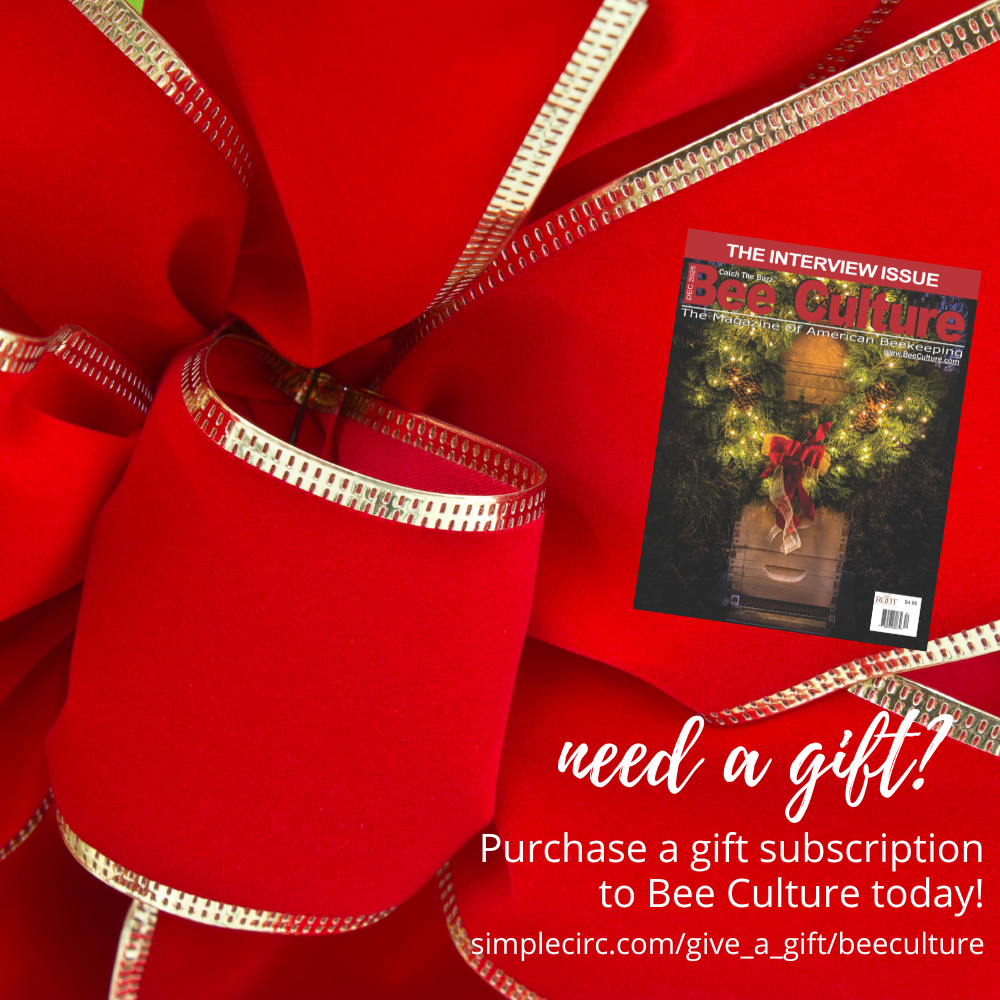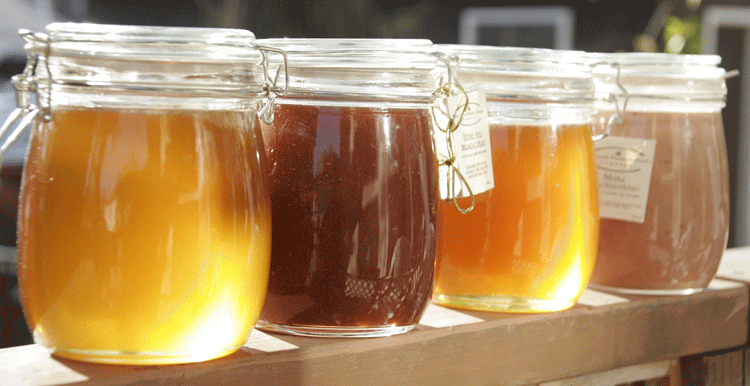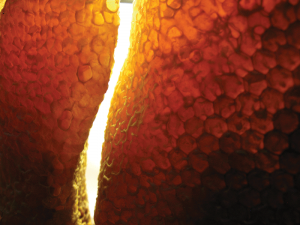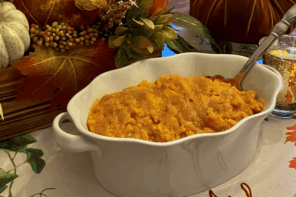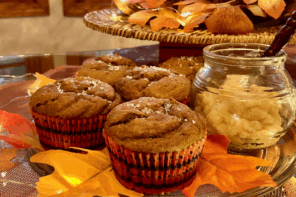30 Tips On Selling Honey. You Don’t Have To Be Clever, Just Honest
By: Leo Sharashkin
“Do you have local honey?” inquired a store customer. – “We surely do, ma’am!”
The associate took the lady to the nook with a large dispenser atop a heating pad. “It is $7.15 per pound and you can fill your own container or ours. This honey has local pollen; many of our clients buy it to help with allergies this time of year.” – “Thank you!”
I thought this typical little scene at a health food store was over, but what happened next grabbed my attention. The salesperson left; the woman took an empty jar to pour some honey in. But then she hesitated, returned the jar to the shelf, and walked over to a display of prepackaged honeys. There was organic honey from Brazil and Canada; standard Grade A clover honey in big jugs; buckwheat, orange blossom, tupelo and other specialty honeys from around the U.S.; comb honey from a local beekeeper; and a variety of others. The woman carefully read several labels and, finally satisfied, put a small jar into her basket and proceeded with shopping.
I looked to see what honey she ended up buying. It was a nine-oz jar of manuka honey from New Zealand for $19.95! Hesitant to buy local honey for $7.15/lb, she paid five times as much for honey from overseas. Why?
I was so intrigued I got a jar for myself, too. Arriving home, we had a tasting. The manuka honey was surely not bad, fragrant and with a distinct flavor, slightly sour and bitter at the same time – but, its purported health benefits notwithstanding, the taste was not superior to the honeys that the Ozark wilderness has to offer. Our citrusy sumac honey or the rich wildflower honey from a hundred different species certainly have their own range of healthful properties, but until a scientist isolates a miracle molecule unique to them, local treatment-free beekeepers sell their honey $10/lb.
I kept going back to that experience when the time came to set price on my own honey. I had started beekeeping to provide uncontaminated honey for my four children, and initially thought I would never have a surplus to sell – using honey as the only sweetener, our household can go through a gallon of honey in a week! But the apiary kept growing; the wild survivor-stock bees (attracted swarms) never ceased to amaze us with their robustness and survival rates in excess of 85%. Eventually, several years ago, I had the first 200 lb to sell. How much should I ask for it?
$20/lb honey flying out the door
Confident that my honey is on par with the most expensive exotic varieties, I set the price at $20/lb. I reasoned: if nobody wants it for this price, we’ll eat it ourselves! This concern proved ungrounded: I sold out the small crop within six weeks. And when I had the last one-pound jar left, someone from Alabama ordered 100 lb through my website, paying $2,000 without even asking for a discount. I picked up the phone and called the customer. “Ah yes, said a pleasant voice in the receiver, we are a small food coop; one of our members tried your honey and was raving about it so everybody decided they wanted a jar.” When I explained I only had one jar left and wouldn’t have more until this time next year – do you know what she said? “Can you keep the payment so we are first in line for the next year’s crop?” This sounded completely surreal, but I refused: I did not want to be under pressure to produce even a hundred pounds. I never feed my bees sugar; in case of a particularly bad year, I would rather leave all honey to the bees than pull the reserves they need for wintering.
“You are an elitist, Leo,” remarked a beekeeper friend when I told her of my success. “You’re a good marketer so you sell honey to people who can afford $20 a jar. Why not produce a pure product that is actually affordable?” She was right, but in all honesty I did not see a way to offer my honey for less, given the high standards of natural beekeeping I follow: no treatments, no sugar feeding, working with local bees, propagating by natural swarming only, stationary well-insulated hives, etc.
For a while I felt guilty of being a greedy elitist, until my sins were forgiven by a customer of mine who stopped by to get three pounds of honey. She lived on social security and had to save even for the most basic of purchases; $60 was a lot of money for her. I felt uncomfortable accepting the money and apologized for my honey being so expensive. “Oh no! Your honey is not expensive for what it is! I’d rather have a teaspoon of your honey than a whole jug of what they sell at the store. Yours is a better deal.”
“More” is “better”?
True, so much of American beekeeping has been about producing honey as a commodity: large volume, low prices. “You need a thousand hives to make a living,” a seasoned Missouri beekeeper told me. But high volume requires high inputs (truck, forklifts, drugs, feeds, hive equipment, hired labor, and bees), and the low profit margins make you vulnerable, because Chinese farmers can still do it for less.
There is a different path: producing a product of the highest possible quality, working with local bees and local plants. I can clearly see that this artisan product – really the “flavor of the place” – is in high demand and finds a market. It does take some marketing skill to make the first sale, but after gingerly trying a jar of my honey many people come back for 10, 20, 30 pounds each year and, as my newest client put it, become “customers for life.”
No matter how wonderful your honey is, to distinguish it from what is available elsewhere, people need your help. Yes, they may literally “taste the difference,” but the story of how it was produced will stay hidden unless you share it with them. So I developed some thirty “selling points” that I communicate in person, on labels, through my website and flyers that I include with every jar I mail out. To be sure, I do not view it as marketing. It’s almost a missionary journey of helping fellow human beings discover one of the essential pleasures of being alive on this beautiful planet – the taste of honey.
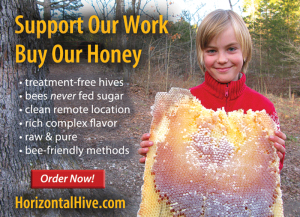
Pictures of our children and honey make great website banners. Beautiful imagery and a clear message – and honey jars just fly out the door! My son Yarosvet with a four-pound comb from a Layens hive.
1. The taste of honey
Flavor, of course, is a highly subjective thing – yet another reason to put my personal opinions aside and go by the reaction of my customers. Here are a few actual quotes – a much higher reward than money:
“Seriously it is the best honey I have ever had. A little piece of Heavenly Glory!” – Tom, Chicago
“Delicious!! Any other honey will taste flat after this one. I forgot what real honey tastes like! Awesome product, will have stocked up for the Winter.” – Louise, Connecticut
“The honeycomb is absolutely amazing. It will be difficult to eat it in moderation. Thank you for what you are doing for the bees.” – Tiffany, California
Hearing such praise is humbling; I certainly take little credit for it. I simply let the bees and the flowers work their magic, trying to interfere as little as possible. The effervescent outpouring of joy that many people experience tasting my honey shows me that I am on the right track with my approach, and that the simple old-time techniques I employ bring great results. I would like to share some of them with you.
2. Made in the USA
The majority of people do not realize that most of the honey consumed in this country is imported. Nor can you assume that honey from a local beekeeper is necessarily local: many keepers move their hives around the country. A health food store owner in Missouri conveyed to me how deceived she felt after discovering that the honey sourced from a local beekeeper turned out to be his crop from three different states down south.
To highlight the truly local character of my crop, I like making reference to local natural landmarks: “Our honey comes from a serene location in the heart of the Ozark Mountains, whereas most of the honey consumed in the U.S. is imported, including from China. Chinese honey is banned in Europe due to lead and dangerous chemicals it may contain, but continues to find its way to U.S. grocery store shelves, often labeled as coming from another country.”
3. Remote woodland location
“We do not have commercial agriculture or industrial plants anywhere close by. It’s so remote we don’t even have cell phone reception! The nearest corn field is some 30 miles away. The nectar and pollen bees gather come from wild-growing flowers and trees which have not been sprayed with pesticides or any other chemicals. The benefit of this seclusion is absolutely pure honey without any traces of pesticides or other chemicals. ”
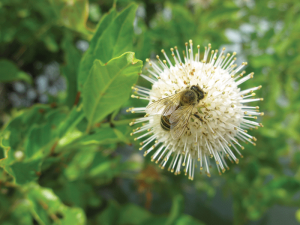
The blossoms of buttonbush fill the air with a tropical, Hawaii-like fragrance. This pretty plant is native to the Midwest and attracts scores of bees with its highly aromatic nectar.
4. Rich biodiversity
Biodiversity means “diversity of life.” Where there is no diversity, life itself is in danger. This is why monoculture farming – prevalent in America today – is so utterly unsustainable, plagued with terrible pest problems and crops and animals prone to disease. Lack of biodiversity hits beekeeping hard – whether we speak about the genetic diversity of honeybees or the flowers they forage.
“Where we live, we literally have hundreds of different species of wildflowers that contribute to the richness of our honey and the health and well-being of our bees. By comparison, much of the commercially produced honey comes from bees pollinating the vast fields of monoculture crops, which can rarely boast the complex flavor characteristic of many honeys produced from wilderness plants.”
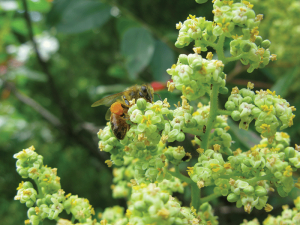
Much of my honey crop comes from sumac – a fast-growing native shrub that thrives even on the poor rocky soil of the Ozarks. It easily spreads by the roots and keeps pumping nectar in dry, hot weather.
5. “Beaujolais nouveau” of a honey
Apart from sustainability, bee health, and flavor, producing honey from the vast diversity of wilderness plants has another benefit: each batch turns out unique, distinct, and unpredictable. Weather patterns during a given season interplay with the idiosyncratic blooming of different plants to produce flavors that rarely repeat themselves. Like wine connoisseurs eagerly anticipating the release of the new harvest’s wine, my customers wait to discover just how the honey will turn out this season. This anticipation is rewarded. Here is reaction of one of my best clients to the taste of the new crop: “The flavor is unbelievable! We’re consuming it with lightning speed and need six more jars. This one is unique, but all your honeys are. You spoil us!” – Lena, New York.
A severe Summer drought one year produced honey with strong bitter overtones of oak and black walnut leaves, apparently from honeydew (very rare in these parts). Another year an early September frost killed aster blooms and the army of foragers probably switched over to the juices of ripe wild grapes that were in great abundance. The Fall crop that year tasted like grape jelly! I could dwell forever on that – but let us move on with our list.
6. We don’t move hives around
“Our hives stay in the same place. Big commercial beekeeping, on the other hand, is largely migratory – hives are loaded by the thousands on trailers and trucked around the country. Moving the bees is completely unnatural, spreads disease, and causes the colonies big stress. Imagine walking out to the porch one morning and discovering your house moved overnight from California to North Dakota!”
7. Sugar-free!
“Like Orbit, our honey is sugar-free! We never feed our bees sugar. The result: healthier bees that live exclusively on the natural diet of nectar and pollen, and no traces of sugar in the honey itself.
8. No chemicals, ever!
“We do not use any chemicals or any other ‘treatments’ on our bees, hives, or honeycomb. As a result, our honey is 100% pure and uncontaminated. By comparison, most commercial beekeepers routinely use chemicals and antibiotics in their hives to prevent bee diseases.
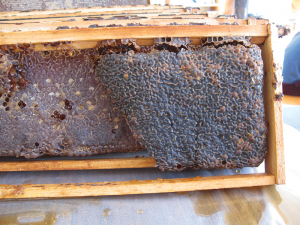
Dark-comb honey aged for three years inside the brood chamber will rival the best of chocolates with its deep and complex flavor.
9. Dark-comb honey
One of the many benefits of being completely treatment-free is that I can safely extract and consume the dark brood frames. This is the flavor I grew up with. My uncle would sell the snow-white comb on the market, but the black honeycomb full of beebread (and cocoons and larval poop too!) was ours the kids to devour. To the extracted honey, dark comb lends a deep amber color and a very particular taste reminiscent of aged whisky. A huge hit with my clients, and definitely a topic for a whole separate article.
10. High pollen count
Extracting brood frames with beebread boosts pollen count in your honey. Pollen is commonly filtered out to conceal the place of origin (as is the case of Chinese honey) or to prevent crystallization. But I am finding that high-pollen-count honey is hugely attractive to anyone who does not view honey merely as a sweetener to squeeze out of a plastic bear.

Combs full of beebread (fermented pollen) are always the first to sell out (as cut comb), and inspire the most exuberant customer reviews. If extracted, they boost honey’s pollen count – the quality sought after by a growing number of consumers.
The preceding points largely have to do with the qualities of honey: flavor, purity, local character, uniqueness, and goodness – but this is just the beginning. Let us look at some of the actual practices of bee husbandry. You may not “taste” them all in the honey, but, as the Little Prince put it, “what is essential is invisible to the eye.” The following represents how and why I do beekeeping. Are you a “beekeeper” or a “honey producer”? To me, there’s a big difference.
11. Local bees
We only keep bees of the local strains. They are better adapted to the local weather, climate conditions, blooming patterns of plants, diseases and parasites than non-local bees artificially bred at large breeding facilities in the South. Every Spring I set out swarm traps in the wild, away from any known apiary – and one box out of two will have a swarm move in. This is the only stock I have ever used, and I couldn’t dream of anything better. By not bringing in any non-local bees, we help to preserve and enhance the local wild honey bee population with its wonderful genetics. I would rather not keep bees at all than contribute to the demise of local honey bees by diluting their bloodline with that of the non-adapted imported stock.
12. Bees come first
“We leave plentiful honey and pollen reserves for the bees in the hive at all times. Good nutrition means healthy and productive bees. We only harvest the real surplus that the bees won’t be able to consume themselves and which, in nature, would be lost to bears, moths, and other honey lovers. So our honey is produced without ‘robbing’ the bees – this is the true surplus that can be extracted without any danger of compromising the bees’ own food stockpiles.”
To do this harvest honey in the spring. This way there’s no guesswork as to how much honey the bees will need that particular winter and the spring honey comes after spending an additional six months inside the hive, which intensifies the flavor (the difference is especially noticeable for dark-comb honey).
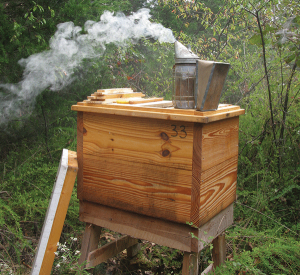
Resilient local bees plus the horizontal hives I use, including this Layens, allow me to manage my yards with two or three visits per year. Laid-back beekeeping at its best.
13. Minimal disturbance
One day I received an email from a fellow beekeeper: “This hive is driving me crazy. I’ve inspected it 19 times in the past three months, and I still cannot find the queen!” I almost felt as though the next email would be coming from the bees: “This beekeeper is driving us crazy. He inspected us 19 times for no other reason than finding the queen!”
We do not do anything like that. Typically, I only open a hive two or three times per year (as was the norm in the days of old): checking it for brood and adding frames in the spring, then pulling honey in the fall. The structure of the horizontal hive allows me to pull honey from one end of the long box with zero disturbance to the brood chamber, which is at the other end. Because I have access to all frames at once, any manipulation can be done quickly without destroying the integrity of the bee nest.

A swarm walks into one of the hives beautifully decorated by my wife, Irina. Swarming is very important for bee health, so I stick to it as the only method of increasing the apiary. I’ve never made a single split.
14. Propagation by natural swarming only
We do not meddle in the love affairs of our bees! They propagate naturally by swarming. This approach is cruelty-free, and produces stronger bees: they eat their own honey and pollen, and the queen has the chance to mate with the best-performing local drones. By comparison, most of the commercial bee colonies are bred artificially, fed sugar syrup, and then shipped to beekeepers in packages together with a queen that was likewise artificially raised and often artificially inseminated.
15. No requeening
By the same token, we do not requeen our hives. Today, the practice of finding the queen, killing her, and giving the hive a new, young one is almost universal. We never do that! If the queen grows old or deficient, the bees will arrange a replacement themselves.
By not requeening, we prevent the artificial bias of passing on to the next generation certain traits at the expense of others. I have some hives that have not given me any honey ever. Yet at the same time these are the hives that have successfully survived, treatment-free, for five years or longer. I let them be, and I know that in the big scheme of things these “non-productive” colonies are extremely valuable to the health of the overall population. They obviously possess certain survival traits that their drones spread to other colonies.
16. “Not tested on bees”
We do not kill bees’ brood with liquid nitrogen. We do not drown bees in alcohol. We do not do any of the other things that have become an accepted beekeeping practice in the name of “fighting the disease.”
I’m seeing “Certified Humane” labels on a growing number of animal products. I am yet to see it on a jar or honey. People who adhere to a vegan diet do not consume any animal products, including honey, concerned with the cruel practices that are part of animal husbandry and beekeeping. I am very proud to have vegans among my customers: they can eat my honey, and this is a very high standard to meet.
17. No queen excluders
We do not use queen excluders and give the bees the freedom to arrange their nest as they would do in nature. The number of frames colonies use for brood is highly variable. With our horizontal hive setup the bees themselves decide how big the brood chamber should be. One piece of beekeeping equipment less for me, and one more step towards better control over the nest space for the bees.
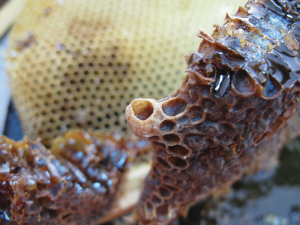
The queen was here. Some chunks of cut comb I sell will have empty queen cells. Chemical-free brood-chamber comb honey is only possible with natural, treatment-free beekeeping.
18. “Chock full of pheromones”
As the queen walks about the comb, her footprint pheromone is being absorbed by the wax. Because I use brood-chamber dark comb for extraction and cut honey, I can claim it contains queen’s pheromones. I do not think that their concentration could ever be high enough for anybody to be able to taste the difference, but I like the thought that my honey is the way nature intended and has the invisible majestic presence that becomes part of you as you ingest it. “There’s nothing royal about ‘royal shrimp,’” wisely observed my son Yarosvet. But hey, there is surely something royal about my honey, and I even have a name for it — the queen pheromone.
19. All-wood, well insulated hives
My bees live in better conditions than I do! My house is built of concrete, plywood, gypsum, MDF, vinyl, bitumen, polyisocyanurate foam and more. The bees’ homes are made of 1½” solid pine; some are double-walled with natural wool for insulation. Well-insulated hives mimic the bees’ natural nest – a tree hollow, and greatly reduce stress from both hot and cold weather.
20. Hives are beautiful
Many of my hives are beautifully decorated. One would say a picture gallery under the open sky. Bees living in beautiful hives make tastier honey. No, this is probably not true, but pretty hives surely produce a better impression on apiary visitors than dilapidated old hives with pealing white paint. And they do have an added benefit: the unique fanciful designs help the bees orient and return to their own hive, reducing drift and the spread of disease.
All right! Thankful for the keeper’s non-intervention, bees have produced a crop of royal honey. Let’s try and not destroy its goodness during the harvest and packaging!
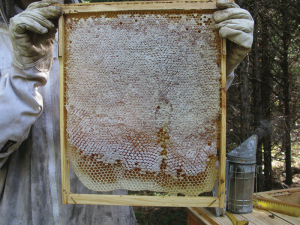
This picture was taken on October 17 – a typical timing of my honey harvest in southern Missouri. After spending the entire Summer in the hive, the honey is fully ripe and almost all cells are capped. When doing a late harvest, move quickly and take all precautions against robbing.
21. Fully ripened in the hive
Because of the horizontal hive’s large volume, bees have plenty of room for the entire season, so there is no need to check them or add more hive space in the middle of the summer when they are highly active. Instead, I can postpone the harvest until Fall (mid- to late October here in south-central Missouri, Zone 6). By that time all surplus frames are fully capped, there are fewer bees and they are preparing for wintering in the brood chamber. I can pull frames with minimal disturbance. The result is honey that has fully ripened in the hive.
22. Not dried or dehydrated
Even when fully capped, my honey rarely has moisture content under 19%. For a number of years I was concerned, because you read everywhere that “honey with over 18.6% moisture may ferment.” However, this was not my experience. My honey commonly has water content between 19% and 19.5%, and never fermented. I could try to bring it down to the magical 18.6%, but I don’t. When you dry honey, you also lose some of its volatile components that make up the aroma.
23. Handmade
We use no electricity in the extraction and bottling process. The hand-crank honey extractor is turned by children’s hands (you don’t really need a motor when kids are around!). There are no pumps, heaters, or uncapping machines. Yes it takes longer, but the harvest turns into a family celebration, instead of being filled with the sounds of working machinery.
24. No plastic jars or comb
The seminal jar of manuka honey I mentioned above was made of amber-color plastic. Initially, I was packing my crop in 1-lb plastic jars, too. Most of my honey goes out by mail, and plastic jars are easier to pack and cheaper to ship.
Everything changed after a customer requested 20 lb packed in glass jars. That doubled the shipping cost, but she was fine with that. “I hate plastic, she explained. And then, Leo, how can you pack your amazing honey in plastic? It cheapens it.” Upon consideration I packed the rest of the crop in glass jars (and included it in the description), and it started selling even better. I never went back to plastic packaging after that.
Many beekeepers use plastic comb or plastic foundation. I don’t – partly because I want to give bees the freedom to build their nest as they see fit (I give preference to foundationless frames), and partly because I see that being plastic-free contributes to the value of my product.
25. Raw, never heated
It’s all in the placement of the comma. My honey is “raw, never heated,” although “raw never, heated” may be more common today. Heating honey can be convenient during extraction and processing; it also slows crystallization. I’ve seen “raw local honey” on tap at a health food store; it was inside a dispenser with a heating element in it!
I use a tangential extractor, and I’m finding it spins honey out very well at room temperature. As for crystallization, I love it – because it’s another indication that my honey has not been heat-processed.
26. Unfiltered
I only use a large-cell stainless steel colander to strain the honey. If it was not for the small hive beetles (one thing I don’t want in my honey!) – I might even skip the straining step. The colander I use lets small bits of wax and pollen through, which will float to the top of the jar after bottling. My customers like that – it’s like “cream-on-the-top yogurt.”
Heating and forced filtering is largely about preventing crystallization, but I actually encourage that.
27. “Improves with age”
I write on my honey: “will beautifully crystallize with age.” Crystallization used to be such a desirable quality in honey that de Layens even describes techniques that promote crystallization. There is absolutely nothing wrong with crystallized honey (even from the marketing standpoint); it all has to do with custom and customer education. What may be viewed as a flaw this moment may become an asset a second later.
28. Never frozen
I find cut comb honey in high demand. It is standard practice to freeze it to kill wax moth eggs that may be present. I refrain from doing that, because freezing and thawing changes the structure of water, and honey is 20% water. Instead, I advise my customers that the comb may have the naturally occurring wax moth eggs in it and should be refrigerated. “That is great!” my best New York customer was enthusiastic. “When I go to a farmer’s market, I always look for lettuce with insect-damaged leaves. If bugs can eat it, it’s safe for me, too! And if an apple happens to have a worm inside, it’s sure indication it was not sprayed. And chilled comb honey – what an exquisite dessert!”
29. Fair trade
We think about fair-trade products are those produced in the developing countries. But why shouldn’t domestic trade be fair, too? My customers enjoy knowing that their money goes directly to support the beekeeping family they know and trust. To the point that even when I offer a discount, half of my long-term clients do not use it. One of them wrote to me in a recent email, after ordering another 10 jars: “I never used any of your 10% off coupons, Leo! Marketing has its wonders I guess!”
30. “Thank you!”
I put it here last, but for me this point actually comes first and permeates all the others. This is what beekeeping means to me.
I feel sincere gratitude to every person who buys my honey. I am seeing a tremendous amount of environmental destruction happening around. Over the last thirty years the area I live in lost half of its forests. Of my six neighbors, three logged out their land in the past seven years. They call it “land improvement.” Lush bee pastures are being bulldozed and converted to fields of sunburned fescue to feed the cows.
I support local bees and the bounty of local wilderness that sustains them and us. My customers support me and my work. So I always begin by saying a big thank you!
The long list of the amazing properties of my honey is not supposed to overwhelm my customers or be a substitute for actually tasting it. So there I stop.
And if you would like to support my work and try our Ozark Wilderness Honey, please visit horizontalhive.com/honey (Or, to order by mail, send a check to Leo Sharashkin, HC 73 Box 470, Drury, MO 65638. $10 for a 4-oz sample, $18 for half-pound, or $25 for a full pound, shipping included. Packed in gift-quality amphora-shaped glass jars.) Thank you!
Dr. Leo Sharashkin is editor of Keeping Bees in Horizontal Hives: A Complete Guide to Apiculture. His forest apiary in the Ozarks is composed entirely of local survivor-stock bees obtained from the wild using swarm traps. His website (including free plans, advice, and talk schedule): http://www.HorizontalHive.com







